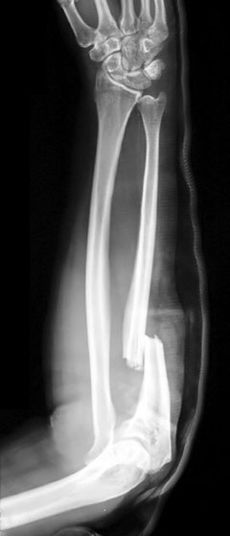- Monteggia fracture
-
Monteggia Fracture-Dislocation Classification and external resources 
X-ray of Monteggia fracture of right forearmICD-10 S52.0 ICD-9 813.03, 813.13 eMedicine orthoped/201 MeSH D009011 The Monteggia fracture is a fracture of the ulna that affects the joint with the radius. More precisely, it is a fracture of the proximal third of the ulna with dislocation of the head of the radius. It is named after Giovanni Battista Monteggia.[1][2]
Contents
Causes
Mechanisms include:
- Fall on an outstretched hand with the forearm in excessive pronation (hyper-pronation injury)
- Direct blow on back of upper forearm. In this context, Monteggia fractures are most commonly seen in defense against blunt trauma (e.g. nightstick injury).
Classification (Bado type)
There are four types (depending upon displacement of the radial head)[3]:
- I - Extension type (60%) - ulna shaft angulates anteriorly (extends) and radial head dislocates anteriorly.
- II - Flexion type (15%) - ulna shaft angulates posteriorly (flexes) and radial head dislocates posteriorly.
- III - Lateral type (20%) - ulna shaft angulates laterally (bent to outside) and radial head dislocates to the side.
- IV - Combined type (5%) - ulna shaft and radial shaft are both fractured and radial head is dislocated, typically anteriorly.
Management
Monteggia fractures may be managed conservatively in children with closed reduction (resetting and casting), but due to high risk of displacement causing malunion, open reduction internal fixation is typically performed.[4]
Results
In children, the results of early treatment are quite good, typically normal or nearly so. If diagnosis is delayed, reconstructive type surgery is needed and complications are much more common and results poorer. In adults, the healing is slower and results usually not as good.
Complications of ORIF surgery for Monteggia fractures can include non-union, malunion, nerve palsy and damage, muscle damage, arthritis, tendonitis, infection, stiffness and loss of range of motion, compartment syndrome, audible popping or snapping, deformity, and chronic pain associated with surgical hardware such as pins, screws, and plates. Several surgeries may be needed to correct this type of fracture as it is almost always a very complex fracture that requires a skilled orthopedic surgeon, usually a 'specialist', familiar with this type of injury.[5]
See also
- Galeazzi fracture
- Hume fracture
- Essex-Lopresti fracture
References
- ^ Monteggia's fracture at Who Named It?
- ^ G. B. Monteggia. Istituzioni Chirurgiche. Vol 5. Milano, Pirotta & Maspero, 1814.
- ^ eMedicine: Monteggia Fracture
- ^ McRae, Ronald; Esser, Max (2008). Practical Fracture Treatment (5th ed.). Elsevier Health Sciences. p. 187. ISBN 9780443068768.
- ^ http://orthopedics.about.com/od/brokenbones/a/forearm.htm
External links
- Monteggia and Galeazzi fractures - wheelessonline.com
- Monteggia Fracture Dislocation - gentili.net
Injury : Fractures and cartilage injuries (Sx2, 800–829) General Head Vertebral Spinal fractureRibs Shoulder, arm
and handShoulderArmHandHip, leg and foot Hip/femurLegFootCategories:- Bone fractures
- Disease stubs
Wikimedia Foundation. 2010.
